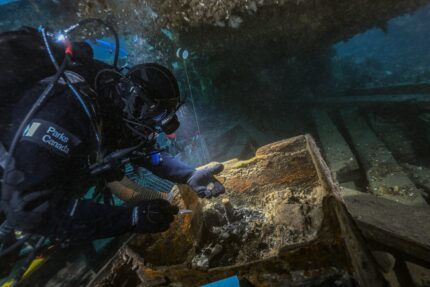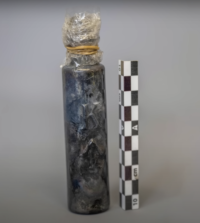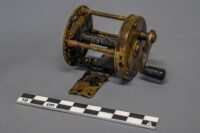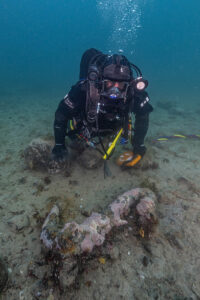 The 2023 exploration of the wreck of HMS Erebus off the coast of King William Island has recovered and documented a fascinating array of personal belongings and naval tools from the ill-dated 1845 Franklin expedition for the Northwest Passage.
The 2023 exploration of the wreck of HMS Erebus off the coast of King William Island has recovered and documented a fascinating array of personal belongings and naval tools from the ill-dated 1845 Franklin expedition for the Northwest Passage.
Parks Canada just released the report on the results of the 2023 dives to document and investigate the ship. In the two weeks between September 5th through the 19th, Parks Canada’s Underwater Archaeology team conducted 68 dives to the wreck of HMS Erebus, moving through the accessible spaces of the ship and debris field. The aim of these dives is to record details about the shipwreck and the objects it carried to shed new light on naval technology and the daily lives of sailors. To that end, the team explored an officer’s cabin, believed to have belonged to Second Lieutenant Henry Dundas Le Vesconte, and found a wealth of instruments pertaining to sailing and navigation, among them a thermometer, a parallel rule and a fishing rod with a brass reel.
 Items of daily use were found in what is believed to have been the storage pantry of the captain’s steward (Edmund Hoar) just forward of Franklin’s cabin. Objects discovered there include a leather shoe, storage jars and a sealed glass cylinder that held some sort of pharmaceutical product. The contents look thick and grey like a less shiny mercury (I hope the doomed Franklin expedition crew didn’t use mercury the same way the doomed Mary Rose crew did). The vial is embossed with the letter “K” and the broad arrow that labelled it government issue.
Items of daily use were found in what is believed to have been the storage pantry of the captain’s steward (Edmund Hoar) just forward of Franklin’s cabin. Objects discovered there include a leather shoe, storage jars and a sealed glass cylinder that held some sort of pharmaceutical product. The contents look thick and grey like a less shiny mercury (I hope the doomed Franklin expedition crew didn’t use mercury the same way the doomed Mary Rose crew did). The vial is embossed with the letter “K” and the broad arrow that labelled it government issue.
 An excavation of a seaman’s chest in the forecastle revealed objects used by regular sailors on the ship. There were some pistols, other military items, footwear, coins, a stoneware bowl and medicine bottles. Only a small selection of the finds were recovered, including the brass fishing reel, the stoneware bowl, the K bottle and one pistol. They will undergo conservation and be studied further in Ottawa before they go on display at at the Nattilik Heritage Centre in Gjoa Haven (Uqsuqtuuq), Nunavut.
An excavation of a seaman’s chest in the forecastle revealed objects used by regular sailors on the ship. There were some pistols, other military items, footwear, coins, a stoneware bowl and medicine bottles. Only a small selection of the finds were recovered, including the brass fishing reel, the stoneware bowl, the K bottle and one pistol. They will undergo conservation and be studied further in Ottawa before they go on display at at the Nattilik Heritage Centre in Gjoa Haven (Uqsuqtuuq), Nunavut.
 Out in the debris field, divers documented one of the ship’s spare propellers (first recorded on the seabed in 2015) and found an ice anchor. This is the first ice anchor found from HMS Erebus or HMS Terror.
Out in the debris field, divers documented one of the ship’s spare propellers (first recorded on the seabed in 2015) and found an ice anchor. This is the first ice anchor found from HMS Erebus or HMS Terror.
The major push to document of the site resulted in thousands of high-resolution digital photographs being taken. They will be used to create extremely accurate and virtually explorable 3D photogrammetry models of the site. The models will allow researchers to follow the effects the movement and sediment are having on the wreck. Already parts of Erebus like the upper deck have collapsed, so scientists are keen to explore the dangers posed by the unforgiving environment.
Wonderful stuff! Just discovered your blog thru Mastodon.
Do you have an option to notify by email when you post?
With thanks,
anna